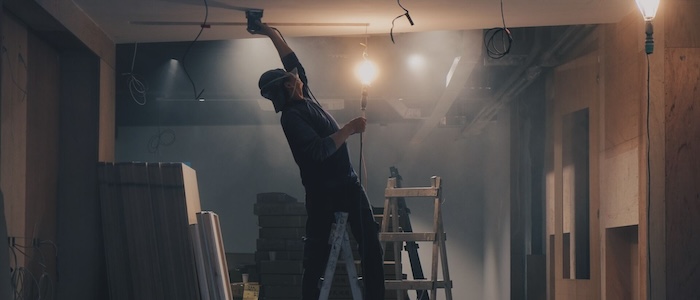Dashpivot Article – ladder safety in construction
Ladder Safety in Construction
This article tells you everything you need to know about ladder safety in construction, and gives you free resources to improve your ladder safety.

Ladder Safety HSE
We use ladders to access hard-to-reach places. It elevates and supports us to work more efficiently. This made ladders a common tool on construction sites. These low-cost yet efficient instruments can provide platforms for operations in elevated regions. Ladders are also versatile. They can be utilised for a number of different tasks on the construction site.
However, there is a catch when using these brilliant tools. Ladders, while valuable in the construction industry, present a lot of hazards in many different aspects. Ladders cause about 500,000 injuries and 300 deaths annually, with an estimated cost of 24 billion US dollars in the US alone. Knowing this, the Health and Safety Executive (HSE) has provided establishments, especially the construction industry, guidelines on ladder safety. To ensure workplace safety, the HSE recommends a logical, appropriate approach to risk management and ladder precautions.
Ladder Safety Procedures
It was established that ladders can be dangerous if the right precautions are not taken. One of the precautionary measures that HSE established to prevent any ladder-related injuries is the guidelines on how to use a ladder. In this section, you will get to know the correct procedures on how to use a ladder, which HSE developed protocols that should be followed before, during, and after utilising the ladder. The safety protocols for ladders are as follows:
Before
Choose the correct ladder: The very first step that workers must do is to assess the area, surface, and nature of work to be done. These things are the required considerations in order to choose the correct ladder for the activity. Using the correct ladder will provide a more stable platform for the user and prevent any unnecessary hazard when doing the activity.
Inspect the Ladder: After choosing the correct ladder, the next step to do is to check the ladder for any damages. This will make sure that the ladder is rigid enough to be used when doing the related activity. To do this, you could make use of a ladder inspection checklist.
that thoroughly checks through the parts of the ladder to ensure its usability and safety.
Consider the User: The last step to do before using the ladder is to choose the appropriate employee/s to use the ladder. You might think that ladders are just tools that anyone can use, but when placed in situations where a number of risks are involved, like construction sites, training is mandatory. It is necessary that only the employees who have undergone proper training on ladder safety can use the ladder. Employees who have undergone training are equipped with the knowledge on how to safely execute a job while using a ladder, eliminating the risks of accidents due to human error.
During
1:4 Rule: When setting up a ladder, HSE recommends implementing the 1:4 rule. This rule states that for every 4 feet of ladder height, a foot should be adjusted from the base of the ladder to the wall. This will maintain a 75° angle of inclination from wall to ladder. Having a 75° angle provides the safest approach since it delivers an ideal balance for stability against the ladder slipping and a good climbing posture.
Extend Properly: After placing the ladder in the correct position using the 1:4 rule, the workers must see to it that the top of the ladder is extended from the landing point. Workers must see to it that the top of the ladder is at least 1 metre from the landing point (this is at least 3 rungs). Doing this provides a solid and secure handhold for the person climbing up the ladder.
Always secure the ladder: Before climbing the ladder, it is necessary that the ladder be secured. This will help avoid the ladder from slipping or falling. HSE has provided options on how to secure a ladder, which are:
- Tie the ladder to a suitable point, making sure both stiles are tied
- Where this is not practical, secure the ladder with an effective ladder stability device
- If this is not possible, securely wedge the ladder
- If you cannot achieve any of these options, foot the ladder. Footing is the last resort
3-Point Contact Rule: When climbing the ladder, HSE highly suggests using the 3-point contact rule. This rule explains that whenever an employee climbs or descends on a ladder, two hands and a foot, or two feet and a hand, should always remain on the ladder. The goal of this rule is to provide good balance and stability and ensure the worker is strongly supported on at least three sides. The importance of the 3-point contact rule must always be highlighted during safety orientations to help workers retain this rule when working with ladders.
After
Clean the Ladder: After using the ladder, housekeeping is always due. Workers who used the ladder must always clean the ladder after use. In the construction area, a lot of contaminants can destroy the integrity of the ladder, and there are times when it is inevitable that the ladders are exposed to such substances. Constantly cleaning the ladder after use will make sure it will be free from these contaminants before storing, which will guarantee a longer useful life.
Store in proper area: Storing these tools properly will shield them from any other external factors that can damage the ladder and compromise the safety of the tool when using them. An ideal storage for ladders is a dry, well-ventilated, and off-the-ground area. This will prevent any moisture build-up, which can cause the ladder to rust. It is also recommended to store ladders in areas with less traffic and heavy activities to avoid denting and damaging them.
Sharing Knowledge on Ladder Safety in Construction
To maintain safety in construction, all workers must have knowledge of the correct safety methods and measures, especially when using ladders. But how do we educate all the workers about these practices? How can you tell them about ladder safety in construction? The answer is toolbox talks
Toolbox talks are short, informal meetings that target safety practices in the workplace. It is also an avenue where workers can openly share about safety issues they experienced in the workplace. With that being said, the goal of educating workers about the correct safety methods is achieved, plus the safety practices are solidified when solutions are made to raise safety issues.
However, to conduct a toolbox talk, a toolbox talk form should be created. This form outlines the safety topic to be discussed and has a field for recording the raised safety concerns. To have a better understanding of what it should look like, take a look at the example below.

Ladder Safety Do's and Don’ts
In this section, we will provide more safety tips when using a ladder on the construction site. We have listed out the do's and don’ts when using a ladder in the construction area. These do’s and don’ts are based on the Occupational Safety and Health Administration (OSHA) ladder safety.
Ladder Safety in Construction "Do’s"
- Before you climb a ladder, be sure that the above electrical cables are safe.
- While ascending or descending, always face the ladder.
- Hold the body inside the rails at all times.
- Ensure that the ladder does not get tipped over to the side or that the base of the ladder does not slip out.
- When you need to use tools on a ladder, you may either use a tool belt or a hand line. Using tools, you should never hold a tool when climbing up or down the ladder.
- Ladders should be cleared of any debris that might cause slipping.
- Utilise a barrier to prevent anyone or anything from approaching the ladder.
- Ladders should only be assembled on non-slip surfaces that are flat.
Ladder Safety in Construction "Don’ts"
- Make use of ladders for a purpose that is not the one for which they were originally created, like making use of a folding stepladder as a single ladder is not recommended.
- Employing a stepladder that has spreaders that are not lockable.
- Making use of the cap or the top step as a step.
- Placing a ladder on cardboard boxes, barrels, or any other foundation that is unstable.
- Moving or shifting a ladder with a person or object on it
- Using the cross bracing on the rear of stepladders when ascending stepladders.
- Applying opaque coatings to a ladder
- Using a ladder that is broken.
- Leaving tools, equipment, materials, and heavy items on a ladder
- Using a stepladder in a horizontal position, similar to that of a platform.
- Using a metal stepladder in close proximity to electrical equipment or power lines.
Construction Ladder Safety Summary
While ladders are considered to be simple tools, they can present numerous hazards when not used properly and when placed in the wrong setting. To avoid any ladder-related injuries or casualties, companies and establishments should obligate themselves to educate their workers on ladder safety in construction. They should provide the workers the proper procedures and the do’s and don’ts when using ladders. One of the platforms that companies can incorporate this knowledge into their workers is through toolbox talks. These informal meetings can be a great avenue to discuss such matters since workers can also voice out their concerns about their safety. With toolbox talks, you can ensure that your workers are equipped with sufficient knowledge about the right safety practices and maintain a healthy and safe workplace.

Safe work method statement ladders
Don't get complacent about ladder safety and the everpresent dangers of working at heights. Ensure everyone is using and working around ladders the right way.

Toolbox Talk Ladder Safety
Keep any work involving ladders safe by running this Toolbox Talk Ladder Safety.

Working at heights permit
Mitigate the risk of dangerous and potentially fatal falls - and make the permit approval process seamless.

